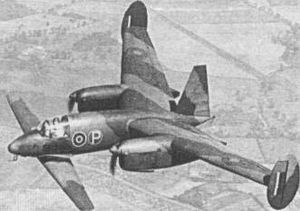Miles M.39B Libellula
| Miles M.39B Libellula | |
|---|---|
 M.39B Libellula M.39B Libellula
|
|
| Type: | Experimental aircraft / bomber |
| Design country: | |
| Manufacturer: | |
| First flight: |
July 22, 1943 |
| Number of pieces: |
1 |
The M.39B Libellula (named after Libellula , a genus of libellulidae ) was during the Second World War developed experimental aircraft with tandem wings of Miles Aircraft . The design should give the pilot the best view for landing on aircraft carriers. The scaled down version served to improve the M.39 construction of a fast bomber proposed by Miles for the Air Ministry Specification B.11 / 41. The M.39 project was canceled, however, and the M.39B was scrapped.
construction and development
M.39
Despite some problems, the predecessor aircraft M.35 showed that the concept worked, and so the larger twin-engine M.39 was designed to meet the specification B.11 / 41, which had been drawn up by the Ministry of Aviation for a high-speed bomber. The specification had been written for the P.1005 proposal by Hawker , which was supposed to reach an estimated 400 miles per hour at 25,000 feet, propelled by two Napier Saber engines, and carry a 2,000 pound bomb load over 1,600 miles. The P.1005 project was canceled after several delays by the Department of Aviation and Miles was able to submit his draft in July 1943. In November 1943 a prototype (with the RAF serial number RR910 ) was ordered, but it did not come to be built. Until the planned (three) W.2 / 500 turbojets were available, the M.39 would be powered by two in-line Rolls-Royce Merlin 60 or Bristol Hercules VIII radial engines . The crew of three people would be housed in a pressurized cabin. In addition to the bomb bay in the middle, the M.39 was supposed to carry two 20 mm cannons in the forewing roots.
M.39B
To test the concept, Miles designed and built the 5/8 scale M.39B. This M.39B, which flew on July 22, 1943, showed no undesirable flight behavior. It coincided with the agency's interest in unorthodox designs in large aircraft. The rear wing was higher than the front wing in order to avoid a downdraft and to ensure ground clearance for the propellers. The M39B had inside flaps and outside ailerons on the rear main wings, while the front wings had a flap system to vary the wing area without changing the lift coefficient .
The Ministry of Aircraft Production signed a development contract and purchased the M.39B. Miles conducted further flight tests and based on the flight data submitted an improved design to the Royal Aircraft Establishment in early 1944 . In 1944 the only M.39B went to the Royal Aircraft Establishment in Farnborough , where it carried out test flights under the registration SR392 . The machine was damaged and repaired twice in accidents, only to be scrapped with the cancellation of the bomber project.
Technical data (M.39B)
| Parameter | Data |
|---|---|
| crew | 1 |
| length | 6.76 m |
| span | Rear wing 11.43 m, front wing 8 m |
| height | 2.82 m |
| Wing area | Rear wing 17.42 m², front wing 5.73 m² |
| Wing extension | Rear wing 7.5, front wing 10.1 |
| Wing profile | Front wing: NACA 23018 (root), NACA 2412 (tip); Rear wing: NACA 23021 (root), NACA 2415 (tip) |
| Arrow | Rear wing 21 ° |
| Wing loading | 540 N / m² |
| Empty mass | 1,091 kg |
| Max. Takeoff mass | 1,270 kg |
| Top speed | 88 kn (163 km / h) |
| Rate of climb | 5.6 m / s |
| Tank capacity | 114 l |
| Engines | 2 × in-line engines De Havilland Gipsy Major IC with 103 kW each |
| Power to weight ratio | 0.16 kW / kg |
See also
literature
- Peter Amos, Don Lambert Brown. Miles Aircraft Since 1925, Volume 1 . London: Putnam Aeronautical, 2000. ISBN 0-85177-787-2 .
- Leonard Bridgman (ed.) Jane's fighting aircraft of World War II . London: Crescent, 1998. ISBN 0-517-67964-7
- Eric Brown: "The Lovelorn Libellula." Air Enthusiast Five November 1977 - February 1978. Bromley, Kent, UK: Pilot Press Ltd., 1977.
- "The Miles 'Dragonflies'" Airplane Monthly , June 1973. London: IPC Media Ltd. ISSN 0143-7240.
Web links
- M.35 Libellula . In: Miles Aircraft History site . January 13, 2006. Retrieved March 29, 2011.
- Jaap Teeuwen: Miles M.35 . In: British Aircraft of WW2 . www.jaapteeuwen.com. Retrieved March 29, 2011.
- Jaap Teeuwen: Miles M.39B . In: British Aircraft of WW2 . www.jaapteeuwen.com. Retrieved March 29, 2011.
- Miles Tandem Monoplanes Flight 1944
- Pictures of Miles Tandem Monoplanes - Flight 1944
Individual evidence
- ^ A b c Peter Amos, Don Lambert Brown: Miles Aircraft Since 1925 . Putnam & Company Ltd., London 1970. ISBN 0-370-00127-3
- ^ Tony Buttler: British Secret Projects Fighters & Bombers, 1935-1950. Midland Publications, Hinckley 2004. ISBN 978-1-85780-179-8 . P. 83
- ^ Buttler p. 86
- ↑ a b c Buttler p. 87
- ^ Buttler pp. 86-87
